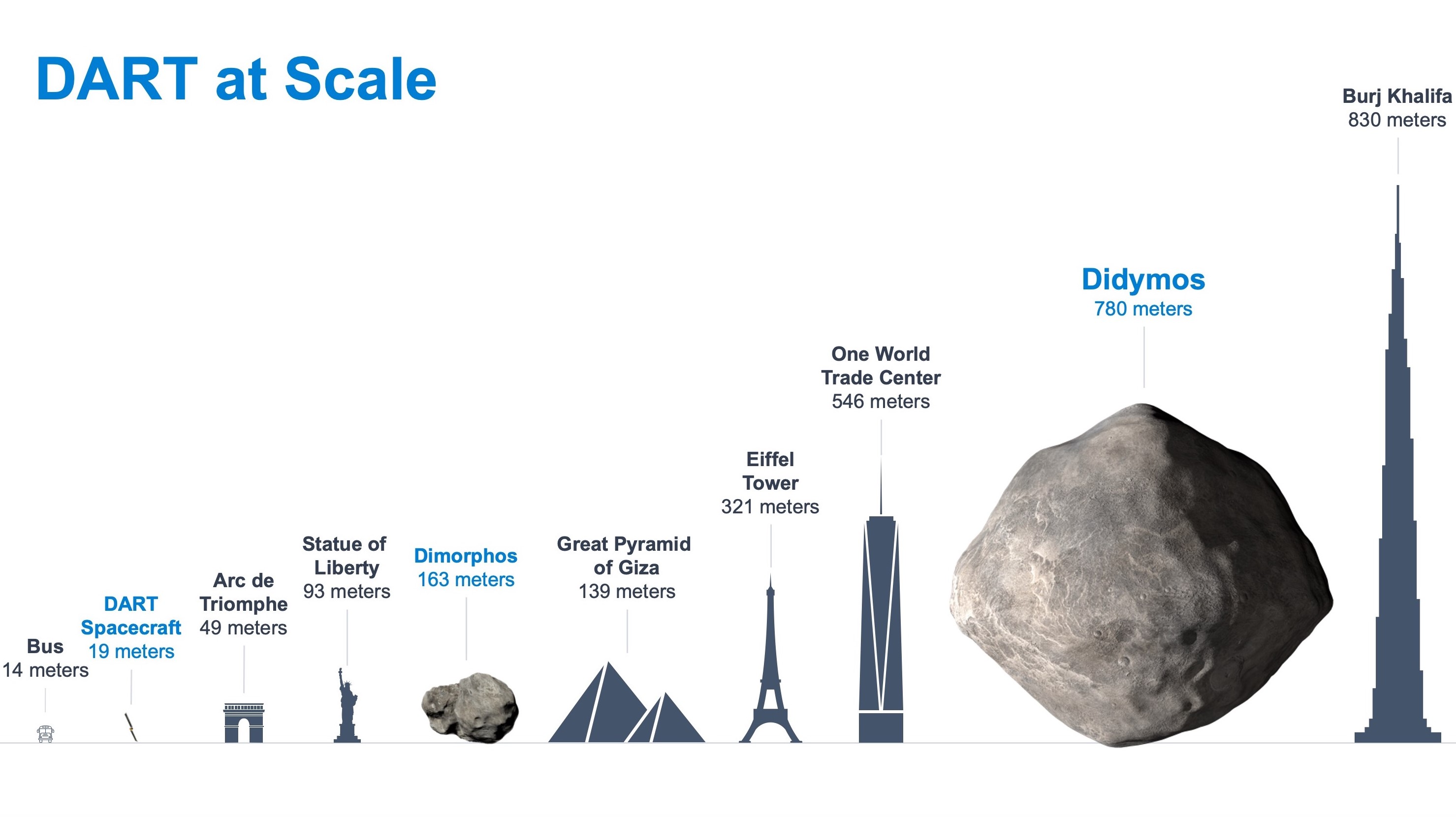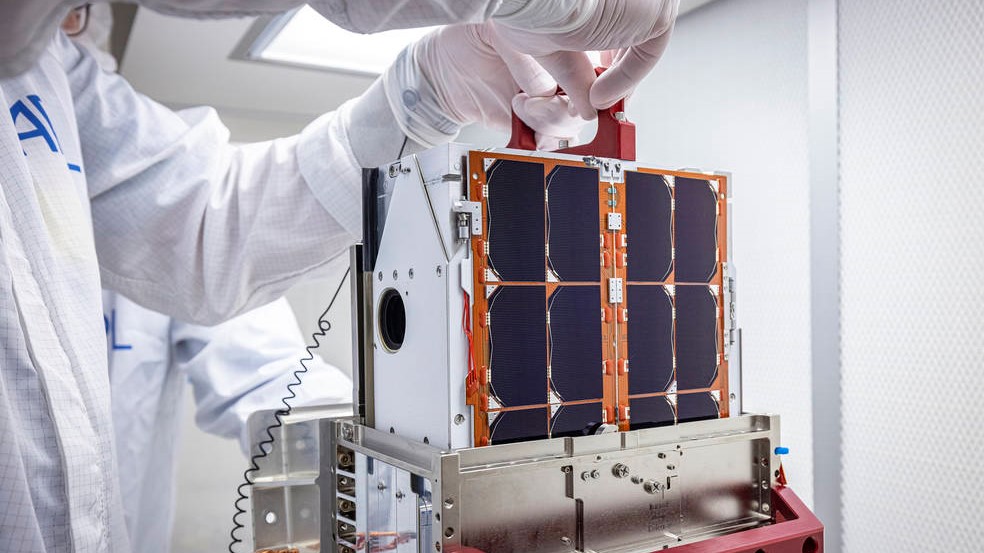NASA’s Double Asteroid Redirection Test mission, or DART for short, is an ambitious project designed to test a method of deflecting an asteroid for the purpose of planetary defense, using the “kinetic impactor” technique.
DART mission key facts
– Launched: Nov. 24, 2021 at 1:20 a.m. EDT (0620 GMT)
– Launch site: Space Launch Complex 4, Vandenberg Space Force Base in California
– Rocket: SpaceX Falcon 9
– Target: Didymos and its moonlet Dimorphos.
– Target distance from Earth: 6.8 million miles (11 million kilometers)
– Estimated cost: $313.9 million (£227.9 million)
– DART Impact window: Sept. 26, to Oct. 2, 2022
The DART mission was launched at 10:20 p.m. local time on Nov. 23, 2021, (1:20 a.m. EDT, or 0620 GMT Nov. 24) atop a SpaceX Falcon 9 rocket from the Space Launch Complex 4 at the Vandenberg Space Force Base in California. The spacecraft is scheduled to arrive at its target in late September 2022, according to NASA officials (opens in new tab).
DART’s target is a binary near-Earth asteroid (65803) Didymos and its moonlet Dimorphos. The DART mission is the first planetary defense mission to test asteroid deflection methods according to The Planetary Society (opens in new tab).
Related: Apophis: The asteroid we thought might hit us (opens in new tab)
DART will deliberately impact the moonlet Dimorphos at speeds of 4.1 miles per second (6.6 km/s). That’s an eye-popping 14,760 mph (23,760 kph). The impact should cause the moonlet’s orbital speed to change by a fraction of a percent according to NASA (opens in new tab). This slight shift should be enough to change its orbital period by several minutes. According to NASA, the change in Dimorphos’ orbit around Didymos will be observed and measured by telescopes on Earth, to see whether the mission has been a success.
DART mission target
(opens in new tab)
Though the threat from asteroid impacts is small, according to The Planetary Society, it is a threat nonetheless, and something we should be prepared for. We only need to look at past impact events such as the massive Chicxulub (opens in new tab) asteroid impact that is credited with the extinction of the dinosaurs 65 million years ago, to see the catastrophic effects an impact can have on life on Earth.
Early detection of near-Earth asteroids is the first step in planetary defense. Approximately 30 new discoveries of near-Earth asteroids (opens in new tab) are made each week and at the start of 2019, there were more than 19,000 discovered near-Earth asteroids according to NASA. DART will be the first mission to test an asteroid deflection technique.
Related: The greatest asteroid encounters of all time! (opens in new tab)
NASA’s DART mission is being led by the John Hopkins University Applied Physics Laboratory (opens in new tab) (JHUAPL). The mission’s target is the binary asteroid system Didymos, which means “twin” in Greek. The system consists of a near-Earth asteroid (65803) measuring 0.48 miles (780 meters) across and its moonlet Dimorphos measuring 525 feet (160 meters) across.
Though the pair are not a threat to Earth, they are perfect candidates for the DART mission as Dimorphos is around the same size as an asteroid that could pose the most likely threat to Earth (if one were on a collision course with the planet) according to NASA. Their orbit around the sun is also close enough to Earth for ground-based telescopes to observe and measure any differences after the collision.
Planetary scientist Nancy Chabot from JHUAPL spoke about the mission strategy with Space.com’s sister publication How It Works magazine.

Nancy Chabot is a planetary scientist at the Johns Hopkins Applied Physics Laboratory (APL) and serves as a project scientist on the Double Asteroid Redirection Test (DART) mission.
“One of the major technology challenges of the mission is targeting a small asteroid in space at very high speed when that asteroid has never been imaged by spacecraft previously”, Chabot said.
“We know from other asteroids that have been explored that they have a range of shapes, internal structures, surface properties and strengths, and these characteristics will influence how much the asteroid Dimorphos is deflected in its orbit around Didymos.”
DART mission operations

(opens in new tab)
DART is a simple spacecraft. According to JHUAPL, the box-shaped main vehicle (opens in new tab) measures roughly 3.9 x 4.3 x 4.3 feet (1.2 x 1.3 x 1.3 meters) — about the size of a refrigerator. Each of the two large solar arrays is 27.9 feet (8.5 meters) long when fully deployed. The DART spacecraft contains just one instrument — Didymos Reconnaissance and Asteroid Camera for Optical Navigation (DRACO). (It turns out if your primary goal is to smash into an asteroid, you don’t need to take a lot with you).
Once the DART spacecraft launches on its SpaceX Falcon 9, it will deploy its Roll-Out Solar Arrays (ROSA) to power itself for the journey to Didymos. Scientists tested the ROSA arrays (opens in new tab) onboard the International Space Station in June 2017 and were deemed suitable to provide the power required to support DART’s electric propulsion system, according to NASA. (In fact, NASA has added larger versions of the ROSA arrays (opens in new tab) to the space station’s own power grid.) The DART spacecraft will also use the next-generation, fuel-efficient NASA Evolutional Xenon Thruster-Commercial (NEXT-C) solar electric propulsion system as part of its in-space propulsion.
According to JHUAPL, DART will be guided to its target Dimorphos by sophisticated autonomous navigation software (opens in new tab). It’s no easy feat to locate a target that is 525 feet (160 meters) in diameter and 6.8 million miles (11 million kilometers) away from Earth. According to JHUAPL, the navigation software is designed to identify both Didymos and Dimorphos and distinguish between the two, so the DART spacecraft can be directed to the smaller body — Dimorphos.
As the spacecraft approaches its target, an onboard high-resolution camera — DRACO will help navigate the DART spacecraft and take measurements of the target asteroid, including the size and shape of Dimorphos. DRACO is based on the LORRI camera from NASA’s New Horizons (opens in new tab) spacecraft.
DART’s companion: LICIACube

(opens in new tab)
According to NASA, the DART spacecraft won’t be making its journey to the near-Earth asteroid binary alone, instead, the spacecraft will be joined by LICIACube (opens in new tab) (Light Italian Cubesat for Imaging Asteroids). LICIACube is a CubeSat contributed by the Italian Space Agency and built by Italian aerospace engineering company Argotec.
According to NASA, the LICIRACube weighs just 31 pounds (14 kilograms) and measures roughly the length of an adult’s hand and forearm. The little CubeSat (opens in new tab) has a very important job and will be deployed by DART around 10 days before the spacecraft will impact Dimosphos. According to Argotec, LICIACube will then hang back and witness the impact, capturing images of the collision to help verify the efficacy of the impact.
Post-impact investigations: Hera mission
ESA’s Hera mission will conduct post-impact investigations of DART’s impact with Dimorphos according to JHUAPL. The spacecraft is planned to launch in 2024 and reach the Didymos binary system in 2026.
ESA’s Hera spacecraft will be joined by two CubeSats. Together, they will carry out surveys of both Didymos and Dimorphos, paying particular attention to the crater left by DART’s collision with Dimorphos. The Hera mission also aims to determine a precise mass of Dimosphos, according to JHUAPL.
Though the two missions, DART and Hera are designed and operated independently, together they will advance our understanding of planetary defense technologies. Team members from both missions are part of an international collaboration known as AIDA — Asteroid Impact and Deflection Assessment. According to ESA, AIDA is a large international collaboration (opens in new tab) between ESA, German Aerospace Center (DLR), Observatoire de la Côte d´Azur (OCA), NASA, and the John Hopkins University Applied Physics Laboratory (JHUAPL).
DART is just one part of a larger planetary defence strategy that is led by NASA’s Planetary Defence Coordination Office, according to Chabot.
“DART’s demonstration of this technology will be a major result to inform future planetary defence activities”, she said.
“Finding, tracking and characterising the near-Earth object population is crucially important to the success of any future planetary defence mitigation efforts, of which DART is just the first test.”
Additional resources
You can view images from the JHUAPL DART mission at the mission image gallery (opens in new tab)Alternatively, learn more about planetary defense with ESA (opens in new tab).
Bibliography
–”DART delayed to November launch as environmental testing begins (opens in new tab)“. NASA Spaceflight (2021).
–”DART, NASA’s test to stop an asteroid from hitting Earth (opens in new tab)“. The Planetary Society (2022).
–”DART Updates (opens in new tab)“. NASA (2022).
–”DART: Double Asteroid Redirection Test (opens in new tab)“. John Hopkins University Applied Physics Laboratory: DART (2022).
–”DART Impactor (opens in new tab)“. John Hopkins University Applied Physics Laboratory: DART (2022).

